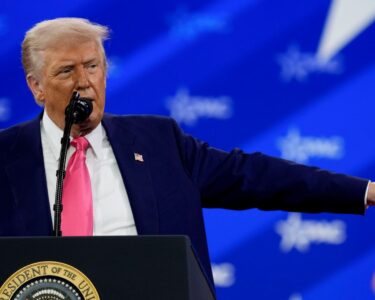At the start of 2023, hopes were high that a much-vaunted Ukrainian counteroffensive — expected to be launched in the spring — would change the dial in the war against Russia.
It didn’t, and the prospect of a breakthrough in 2024 is also unlikely, military experts and defense analysts told CNBC.
They predict intense fighting is likely to continue into the next year but say Kyiv’s forces are unlikely to launch any more counteroffensives. Russia, meanwhile, is likely to focus on consolidating the territory it has already seized, particularly in eastern Ukraine.
Away from the battlefield, military experts said that the trajectory the Russia-Ukraine war takes in 2024 will mostly be dictated thousands of miles away in the U.S., Ukraine’s largest military supporter, and whether aid declines in the run-up — and following — the U.S. presidential election.
“War is an uncertain endeavor,” retired Army Lt. Gen. Stephen Twitty, former deputy commander of the U.S. European Command, told CNBC.
“Russia can win the war, or the Ukrainians can win the war. And, as you’re seeing things now, if you really think about it, what has been achieved this year? Very little has been achieved by Russia, and you can say the same thing for the Ukrainians,” he said.
“We’re in this situation now where if there’s not a clear winner, there’s going to be a stalemate, and there’s going to be, perhaps, a future frozen conflict. What can tilt the balance, in my view, is if the Ukrainians are not resupplied and they’re not re-funded and they don’t get the equipment and people that they need. Then this war could tilt to the Russians,” Twitty noted.
A year ago, Ukraine’s international military support was solid with NATO pledging to support Kyiv for “as long as it takes” as it defended itself against Russia’s invasion launched in February 2022.
Over the summer, however, the challenge facing Ukraine’s forces was glaringly obvious as they struggled to break through heavily fortified Russian positions and lines of defenses along a swathe of the 600-mile-long front line across the southern and east of the country.
After liberating a handful of villages in the summer, Ukrainian and Russian forces have been caught in largely attritional battles, with neither side making significant gains.
Ukrainian military officials have conceded that hopes and expectations of a great breakthrough in the counteroffensive were not met. Still, Ukraine’s leadership says that steep losses have been inflicted on Russian forces and that its forces have made vital progress in other areas such as the Black Sea with Ukraine’s audacious attacks on Russian bases and assets in Crimea this summer prompting the Russian navy to withdraw a number of warships from Sevastopol, handing Kyiv a victory in the battle of the Black Sea.
Weather conditions are deteriorating in Ukraine, with mud, freezing rain, snow and ice making offensive and reconnaissance operations challenging. Intense fighting continues nonetheless, and particularly around Bakhmut and Avdiivka in eastern Ukraine where Russian forces are conducting offensive operations and have made some recent, confirmed advances.
Analysts at the Institute for the Study of War noted last week that Russian forces have likely committed to offensive operations in multiple sectors of the front, during a period of the most challenging weather of the fall-winter season, “in an effort to seize and retain the initiative” before the Russian presidential elections in March 2024.
In the meantime, the ISW noted in an analysis, “Ukrainian forces establish and consolidate defensive positions to conserve manpower and resources for future offensive efforts.”
Ukrainian forces have adopted a more defensive stance as circumstances dictate; a senior army general warned last week that front-line Ukrainian troops face artillery shortages and have scaled back some military operations because of a shortfall of foreign assistance.
Another year of war in Europe has undoubtedly drained Western military resources and the political appetite to maintain massive amounts of military aid for Ukraine.
Ongoing funding for Ukraine is far from secure in 2024 given the fact that the U.S. presidential election could herald a seismic change in the attitude toward and support for Kyiv.
Specifically, all eyes are on former U.S. President Donald Trump, the Republican front-runner, who cultivated close relations with his Russian counterpart Vladimir Putin during his presidency.
There are concerns that, given Trump’s previous good relations with Moscow and “America First” policy, aid for Ukraine could be shelved rapidly. Defense analysts agree that much of the outlook for Ukraine is dependent on the outcome of the U.S. vote.
“I think it’s important to understand the extent to which Ukraine is reliant on the U.S. right now, because it’s quite significantly more reliant on the U.S. than it is on the EU,” Sam Cranny-Evans, defense analyst at the Royal United Services Institute defense think tank, told CNBC.
“If the U.S. election goes in a way that is not in Ukraine’s favor, coupled with the fact that the EU is not really stepping up to the plate — it’s ammunition production is so far off what it should have been by now to give Ukraine a hope of surviving and a hope of victory — it’s not a very cheery prediction for 2024.”
Rumblings of discontent over continuing Ukraine aid have been heard in some Republican quarters for months now, as well as in Eastern Europe.
Former U.S. Ambassador to NATO Kurt Volker told CNBC he believes American and EU aid packages for Ukraine will be approved come January, saying he believed this funding would tide Ukraine over for another year, militarily. Volker said that aid packages must include more advanced weaponry for Ukraine, however, like F-16 fighter jets which have been pledged by Norway, Denmark and the Netherlands.
Ukrainian pilots are beginning their training on the jets now but it could be a number of months before they’re deployed in Ukraine. The U.S. is not providing F-16s to Ukraine but has authorized allies to provide their own jets.
“A couple of things ought to change,” Volker told CNBC. “We ought to lift restrictions on the weapons we’re providing. We still don’t provide the longest-range missiles and we still have not delivered any Western aircraft in Ukraine yet. Those things have to happen. And I think we have to try to give the Ukrainians more of a technological advantage,” he noted.
Volker believes that a Trump presidency might not be the catastrophe for Ukraine that is feared, but said it would make future funding uncertain.
“I doubt that even if Trump were elected that he would abandon support for Ukraine overall, because it would be a disaster for U.S. interests, and it would appear to be a failure. You’d have these images of Russians overrunning places, and brutality and so forth, so I don’t think he wants that. But it’s not clear exactly what he would do to try to end the war.”
For his part, Trump has said that he’d be able to resolve the Ukraine war “in one day” if he was reelected, saying he’d convince the leaders of Ukraine and Russia to make a deal.
Russia has shown that it is committed to a long conflict in Ukraine and that it has the capacity to send hundreds of thousands of men to war. Putin claimed in his end-of year news conference that 617,000 troops were currently active in Ukraine.
Putin denied a second wave of mobilization was necessary for now, but in early December he signed a decree ordering the military to increase the number of Russian armed forces personnel by 170,000, bringing the total number of troops to 1.32 million.
Russia is also massively boosting military spending in 2024, with almost 30% of its fiscal expenditure to be directed toward the armed forces. Its military-industrial complex has also ramped up the production of hardware from drones to aircraft.
Ukraine’s Defense Ministry said last week that its main goal in 2024 is to boost its domestic defense industry in the face of uncertain future supplies from its Western allies. It has also changed conscription laws, foreseeing the need to bolster its forces, which are dwarfed in size by Russia’s but are more highly trained and equipped. Ukrainian President Volodymyr Zelenskyy said last week that the military had asked for up to 500,000 additional conscripts but said he needed to hear “more arguments” to support the sensitive and costly proposal.
With both Ukraine and Russia investing heavily in the war, it’s unlikely there will be any negotiations to end the conflict or agree to a cease-fire. Defense analysts argue that neither side would want to go into negotiations unless they’re in a position of strength and able to dictate terms.
“In the case of a Republican winning the presidential election next year, especially if that’s Donald Trump, who seems to be the front-runner, and [if] funding is decreased substantially, then there will be increased pressure on Ukraine to negotiate,” Mario Bikarski, a Europe and Russia analyst at the Economist Intelligence Unit, told CNBC.
“Of course, Ukraine currently doesn’t want to negotiate … but given the circumstances, it will have little choice but to comply with that. And then the question also remains if Russia will be willing to negotiate because if there are signs that the West will stop supporting Ukraine, and Ukraine will be coerced into these negotiations, Russia might see this as another window of opportunity to consolidate a lot more gains.”
Defense experts told CNBC their baseline scenario for 2024 was a continuation of the current intensity of fighting but the same sense of stalemate with neither side able to progress much on the ground and take or reclaim territory.





